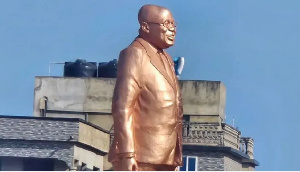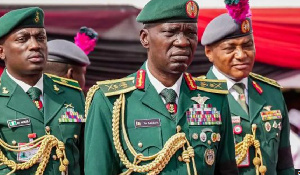Opinions of Sunday, 26 October 2014
Columnist: Hudu, Mahama
It Is Ghana’s Oil
The uniqueness of oil and gas is such that the way it’s approached by government and the citizens of a state, especially when it is mutually agreed that precious minerals and natural resources under any territory belongs to the sovereign state in which they were discovered makes it a non-negotiable issue.
Four years after production of oil in commercial quantities, Ghanaians are searching for answers to two questions: Do we own the oil? If yes, why do we receive only 10% of the oil proceeds?, and Does Ghana truly share the oil with neighbouring ivory cost?
1. Do we own the oil? If yes why do we receive only 10% of the oil proceeds?
The general assumption which influenced this thinking is that, if it is undoubtedly agreed around the world (apart from US) that any mineral resource on the ground belongs to the state, then the proceeds from extraction and sale of what the state owns should predominantly belong to or controlled by the people. This also leaves industry tax officials a lot of task to explain the concessionary and contractual tax regimes to the local people and why the choice of one.
In the current regime in Ghana, royalty on Gross Production of Crude Oil Percentage varies from block to block, and it’s water depth dependent. It ranges from 5% - 12.5% of gross production of crude oil. Ghana’s Carried Interest ranges from 10% to 15% in each contract area, but in most contracts so far, it is fixed at 10%.
This interest is “carried” during the exploration and development stages with the international oil company bearing all the risk through project finance. The Petroleum Income Tax Law (PITL) sets default rate at 50%, but has since been operated at 35%; this is what Jubilee is operating with. Deduction and Cost Containment is Unlimited carry-forward of losses under PITL. Five-year straight-line depreciation of exploration and development costs and other capital thus decommission cost, expatriate nationals exempted from tax and exemption of import duties exist.
The country do not have any upfront payment as in the case of Nigeria which has offshore signature bonus ranging between $10m for up to 200ms and $20m for 1000ms and above , 0.2% of price for 50mm bbls and 0.1% of price for 100mm bbls.
Initial exploration period of US$ 30 per sq km, 1st Extension Period of US$ 50 per sq. km, 2nd Extension Period of US$ 75 per sq km exist in Ghana’s surface rental provisions.
In most regimes, government take is determined by the speed at which the international oil company recoups its investment. Also, as profit is at the heart of every investor, a measure of profit-to-investment ratio decides the international oil company’s investment decision and the exploration cover ratio, the outcome of any particular exploration should be able to inform the investor about the reserve prudence.
The concessionary regime satisfies GNPC’s aim since it is relatively risk-free, the oil companies bear all the financial risks as well as provides the technical expertise, equipment and capital for the project. The system allows the government to exercise some control or at least have a say on decisions regarding the exploitation of its resource. State participation enables the GNPC and it personnel to gather the needed experience and expertise- to strengthen the human resource base of the country.
Companies tend to be quite conventional in their bid offers for concession areas which are considered risky, in the sense that not much is known about the prospect of the area, this is especially so in new sites. The government would therefore be disadvantaged if it is relying on substantial up-front payments.
This regime exposes Ghana to difficulties in the determination of the optimal thresholds, the ROR bands, and the applicable progressive take for each contract. In addition, the absence of cost recovery limit in Ghana’s fiscal regime, the absence of thin capitalization provisions and hence limits on interest deductibility, this also compromise the degree of progressivity that can be attained through the income tax and AOE.
Base on the above guidelines and actual figures of what the people of Ghana receive from jubilee operations , it is realised that in the first half of 2012 lifting for instance, out of a total of 5,871,464 bbl lifted, 4,874,980bbls representing 83.03% went to the partners, whiles 996,484bbls representing 16.97% went to GoG.
In the second lifting of the same period, the partners took away 3,880,826 bbl (66.07%) from 5873709 bbl whiles GoG carried home 1,992,883bbls (33.93%). In the whole exercise within the period, the partners of jubilee took 74.55% whiles GoG carried 25. 45% of oil lifted. This goes to show that per the modelled petroleum agreement of Ghana, the 10% on royalties paid to GoG does not suggest the entire package for Ghana.
Does Ghana truly share the oil with neighbouring Ivory Coast?
The Ghana-Cote d’Ivoire boundary extends for approximately 415miles between the Gulf of Guinea and tri-point with Upper Volta. It follows various rivers including the thalweg of the Black Volta. More than half of the boundary consists of straight-lines segments which are demarcated by pillars.
Prior to the independence of both states, Anglo-French treaties determined the present-day boundary between the two African states. Ghana became an independence state on March 6, 1957. On December 4, 1958, the Ivory Coast became an autonomous republic within the French community and on August 7, 1960 the republic of the Ivory Coast was proclaimed independence under the terms of an accord with France. Established in 1968, a demarcation commission for Ghana- Cote d’Ivoire boundary has met regularly since 1970.
Earlier, an Anglo-French arrangement of 10th August, 1889, stated that the boundary between their respective possessions on the Gold Coast started at Newtown and extended inland to the Lagune Tendo. It then followed successively the left banks of the Lagune Tendo, the Lagune Ehy, and the Tendo River to Nougua. The boundary was to continue northward to the 9th Parallel in accordance with various treaties concluded by British and French Government with local chiefs.
But the United Kingdom and France concluded an arrangement on July 12, 1889, delimiting the boundary between the Gulf of Guinea and the 9th parallel in greater details than had previously been the case. Separate frontiers were delimited for the British and French possessions between Lagune and Tendo and Nuogoua.
On June 26, 1891, an agreement was signed by the United Kingdom and France, which delimited -in details- the boundary from Nougoua to the 9th Parallel, with northern sector following the Black Volta.
The General Assembly of the United Nations by its Resolution 1105(xi) adopted on February, 21 1957 called for a conference of its members to examine the law of the sea taking accounts not only of the legal but also the technical, biological, economic and political aspects of the programme and to embody the results of its works in one or more international conventions or results. The Geneva conference on the law of the sea was convened on February 24, 1958. Four conventions emerged from the conference after much discussions, debates and toils and are now subject to ratification. These conventions are the territorial sea, continental shelf, exclusive economic zone, and contiguous zone and high seas conventions.
Meanwhile, control over the world’s oceans has been a source of international debate since the early seventeenth century. Maritime powers have traditionally sought to maximize control over the sea and, until the late nineteenth century, coastal state jurisdiction on offshore was generally limited to determination by the ‘cannon-shot rule’, (the distance that a cannon ball fired from the shore could reach offshore). Nevertheless, the twentieth century saw a dramatic expansion of state control over maritime space. A series of international conventions signed in Geneva in 1958 were partially successful in codifying the law of the sea, but it was not until 1982 that a comprehensive regime for the world’s oceans was agreed in the form of the United Nations Convention on the Law of the Sea (UNCLOS).
Under UNCLOS, states are entitled to claim rights over the resources of the sea and seabed up to at least 200 nautical miles from their coast. As a result, more than 30% of the world ocean now falls under state jurisdiction, with overlapping maritime zones creating the need for 430 international maritime boundaries.
In November 2011, the Government of Ivory Coast mapped out a new maritime border it is sharing with Ghana covering some of Ghana’s Jubilee oil field and has therefore publicly challenged Ghana over title to the offshore acreage that is hosting Tweneboa, Enyenra and Owo wells. Border disputes are infamously not easy to resolve because Coastal States are not willing to lose cases since it has some political connotations as well as loss of national interest. The absents of a clear set of rules established through international conventions or jurisprudence determining states sovereignty over territory in the countenance of competing realistic claims is also attributed to this.
Africa is prone to conflict and tran- boundary disputes over natural resources. The diamond conflict in Sierra Leone and the Niger Delta in the 1990s, Nigeria and Cameron clashed over Bakassi Peninsula deposits. Dispute between Botswana and Namibia over hydrocarbons deposit in Sedudu Island in the Chober River in the 1990s are fresh in memory.
Many supportive approaches to resolve border issues have been implemented by states on an agreed basis, or as a result of dispute resolution assistance which include joint development or joint operating agreements , such as in the case of the 2001 joint development agreement between Nigeria and Soa Tome -over both countries territorial waters . So the worse Ghana can get from this international arbitration between the two nations by UNCLOS is joint development from the affected wells.
Mahama Hudu
Center for Energy Research- Ghana
Email: mahama_2020@yahoo.com
Tel: (0506734457)
Entertainment










